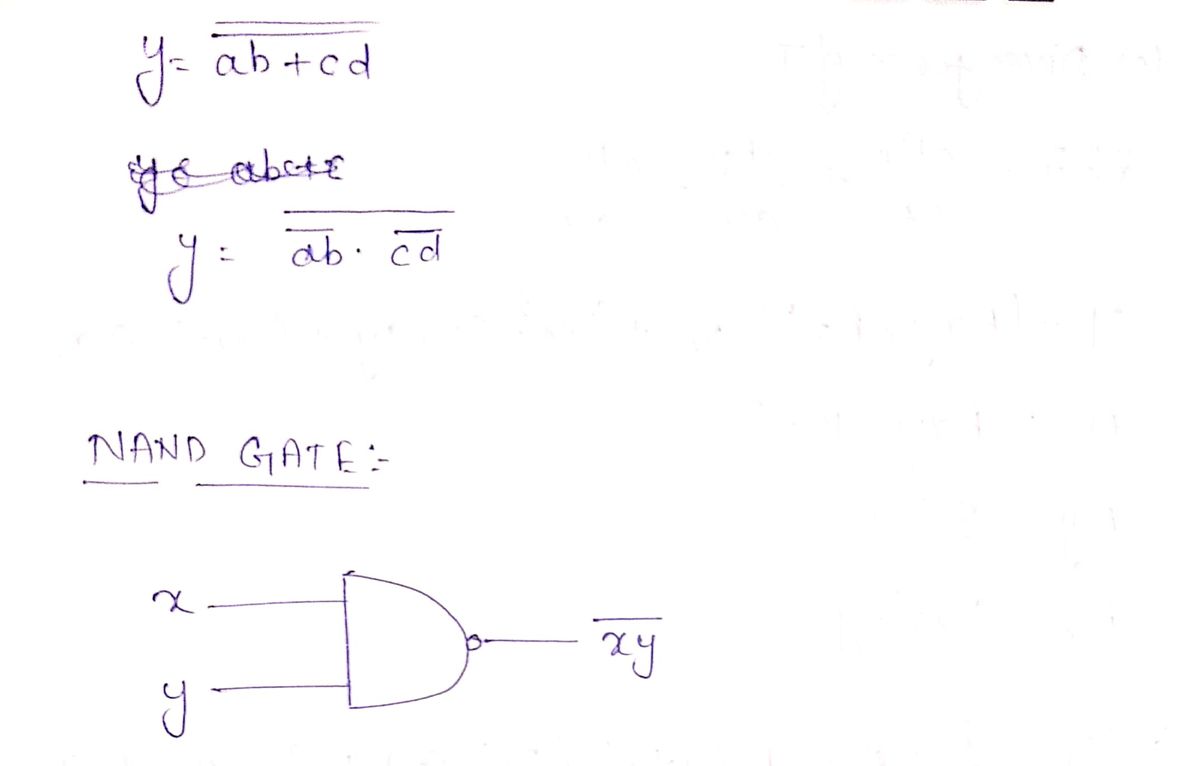nử function inter circuit on ly using NAND (rates abted
Introductory Circuit Analysis (13th Edition)
13th Edition
ISBN:9780133923605
Author:Robert L. Boylestad
Publisher:Robert L. Boylestad
Chapter1: Introduction
Section: Chapter Questions
Problem 1P: Visit your local library (at school or home) and describe the extent to which it provides literature...
Related questions
Question
![**Title:** Transforming Boolean Functions into NAND Circuits
**Objective:** Learn how to convert a given Boolean function into a logic circuit using only NAND gates.
**Task:**
Convert the following Boolean function into a circuit using only NAND gates:
\[ y = ab \text{cd} \]
**Explanation:**
To convert this function into a circuit using only NAND gates, consider the properties of the NAND gate. The NAND gate is universal, which means any Boolean function can be implemented using only NAND gates.
**Steps:**
1. **Apply De Morgan's Theorems** - Begin by expressing the function in terms of NAND gates.
2. **Double Negation** - Use double negations and the transformation logic to recreate AND, OR, and NOT functionalities using only NAND gates.
3. **Build the Circuit** - Draw a schematic using these transformations to represent the original function with NAND gates.
**Note:**
This is a fundamental skill in digital electronics and logic design, emphasizing the versatility of NAND gates in implementing any digital logic.
For detailed guidance and examples, refer to our digital electronics module.](/v2/_next/image?url=https%3A%2F%2Fcontent.bartleby.com%2Fqna-images%2Fquestion%2F39c6e25e-d467-4ba4-a648-1f12925c88db%2F02d74773-edde-40e6-867d-fd8a862ca523%2Fqj3b363.jpeg&w=3840&q=75)
Transcribed Image Text:**Title:** Transforming Boolean Functions into NAND Circuits
**Objective:** Learn how to convert a given Boolean function into a logic circuit using only NAND gates.
**Task:**
Convert the following Boolean function into a circuit using only NAND gates:
\[ y = ab \text{cd} \]
**Explanation:**
To convert this function into a circuit using only NAND gates, consider the properties of the NAND gate. The NAND gate is universal, which means any Boolean function can be implemented using only NAND gates.
**Steps:**
1. **Apply De Morgan's Theorems** - Begin by expressing the function in terms of NAND gates.
2. **Double Negation** - Use double negations and the transformation logic to recreate AND, OR, and NOT functionalities using only NAND gates.
3. **Build the Circuit** - Draw a schematic using these transformations to represent the original function with NAND gates.
**Note:**
This is a fundamental skill in digital electronics and logic design, emphasizing the versatility of NAND gates in implementing any digital logic.
For detailed guidance and examples, refer to our digital electronics module.
Expert Solution
Step 1

Step by step
Solved in 2 steps with 2 images

Knowledge Booster
Learn more about
Need a deep-dive on the concept behind this application? Look no further. Learn more about this topic, electrical-engineering and related others by exploring similar questions and additional content below.Recommended textbooks for you

Introductory Circuit Analysis (13th Edition)
Electrical Engineering
ISBN:
9780133923605
Author:
Robert L. Boylestad
Publisher:
PEARSON

Delmar's Standard Textbook Of Electricity
Electrical Engineering
ISBN:
9781337900348
Author:
Stephen L. Herman
Publisher:
Cengage Learning

Programmable Logic Controllers
Electrical Engineering
ISBN:
9780073373843
Author:
Frank D. Petruzella
Publisher:
McGraw-Hill Education

Introductory Circuit Analysis (13th Edition)
Electrical Engineering
ISBN:
9780133923605
Author:
Robert L. Boylestad
Publisher:
PEARSON

Delmar's Standard Textbook Of Electricity
Electrical Engineering
ISBN:
9781337900348
Author:
Stephen L. Herman
Publisher:
Cengage Learning

Programmable Logic Controllers
Electrical Engineering
ISBN:
9780073373843
Author:
Frank D. Petruzella
Publisher:
McGraw-Hill Education

Fundamentals of Electric Circuits
Electrical Engineering
ISBN:
9780078028229
Author:
Charles K Alexander, Matthew Sadiku
Publisher:
McGraw-Hill Education

Electric Circuits. (11th Edition)
Electrical Engineering
ISBN:
9780134746968
Author:
James W. Nilsson, Susan Riedel
Publisher:
PEARSON

Engineering Electromagnetics
Electrical Engineering
ISBN:
9780078028151
Author:
Hayt, William H. (william Hart), Jr, BUCK, John A.
Publisher:
Mcgraw-hill Education,